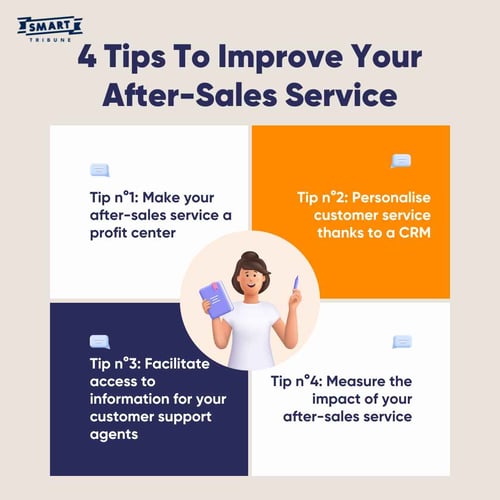
After-sales service is an area in which all companies have an interest in innovating: 72% of consumers demand more efficient customer service (Zendesk).
For a company, after-sales service should be perceived as a real strategic lever for customer satisfaction and loyalty. It allows you to:
- Build a relationship of trust with customers
- Enhance brand image
- Efficiently differentiate yourself from the competition
- Drive customer advocacy
Inversely, poor quality customer service, lacking reactivity, could have a very negative effect on a company’s performance and reputation.
So here is our advice for better management of your after-sales service in order to make it more sustainably satisfying for your customers.

Tip n°1: Make your after-sales service a profit center
For many companies today, customer service is still considered a cost center. However, this flawed vision is starting to change.
It is widely known that retaining a current customer costs less than acquiring a new one:
On average, client acquisition costs 7 times more than customer retention.
As such, customer satisfaction and customer loyalty become key stakes for companies, resting in the hands of customer service teams. On the other hand, it appears that the quality of after-sales service has a major influence on purchase decisions, and therefore on sales.
After-sales service therefore should be considered as a profit center for the company. After all, the quality of service, and more generally, customer relations, are central elements for the company, with as much of an influence on brand image as on financial results.
After-sales services that act as a profit centre should function efficiently in order for agent's to close a sale. To make that happen, it’s important to free up customer service agents’ time when it comes to dealing with low value-added support requests, in order for them to be able to concentrate on higher value-added requests. Such as providing answers and helping with complex issues or presenting new offers and upselling to customers.
Time optimization and work organization for customer service agents can be facilitated and can also drive conversions thanks to self-service solutions and different tools that can be put in place, such as: AI chatbots, dynamic FAQs, and more.
Tip n°2: Personalise customer service thanks to a CRM
A CRM solution is a tool that allows you, among other things, to centralize customer information and all exchanges with agents.
It’s a centralized database, accessible to all company employees, with levels of access that can be adjusted as needed. Thanks to customer history and the traceability of customer data, contact management is facilitated for agents, providing better customer knowledge.
Furthermore, customers don’t have to repeat themselves, for example, to remind an agent of a previous exchange, which results in time savings for them as well as for your employees. Think of a CRM as a preventive maintenance tool that will fluidify support exchanges and create a smooth customer journey which can increase satisfaction with the brand and in the long run create a loyal customer.
With a CRM, bringing a rapid and relevant response to the client becomes easier. The information provided by the after-sales service can be further personalized, and the client feels better cared for. Discussions with customers are encouraged. Finally, the relationship with the customer is under control and the agent has an omniscient position when it comes to the customer network.
Today, this type of tool is indispensable to ensure the better functioning of your multi-channel after-sales service. And as a result, you’ll provide more customer satisfaction.
The numbers speak for themselves, based on a Tech News World study:
74% of companies improve the performance of their customer service thanks to a CRM.
Ultimately, adopting a customer relationship management solution is part of a customer-centric strategy, which will allow you to further place the client at the center of your customer service actions.
Tip n°3: Facilitate access to information for your customer support agents
The Cultural Services 2019 report taught us that 1 out of 3 people think that employees are not sufficiently trained in customer service. Facilitating access to training materials and information for your customer service agents is essential so they can provide the best sales support.
Your agents should be as informed as possible, in order to be able to satisfy your customers and respond to their requests. An employee who doesn’t know how to efficiently resolve a claim on their own will generate impatience in the customer.
Furthermore, the agent will have to solicit the help of a more highly-qualified colleague or manager to resolve the issue at hand. The increase in resolution time, customer frustration and the mobilization of additional resources are negative for the company and should be avoided as much as possible.
Better training for agents allows you to avoid a dysfunctional customer service experience.
To provide better training, internal self-service solutions can be implemented in after sales services. These solutions limit requests for assistance through the automation of responses; they facilitate access to the company knowledge base, and they make agents more autonomous in the resolution of customer service requests.
Customer service agents can be more flexible in their support actions or in the information they can give to customers. Internally, self-service tools contribute to the construction of a more efficient, better organized and more fluid after-sales service in the eyes of the customer, who will have fast, autonomous agents at their service.
On their side, agents will be more satisfied in being able to respond rapidly and succinctly to customers, which contributes to the improvement of day-to-day employee wellbeing which can lead to increased productivity.
Tip n°4: Measure the impact of your after-sales service
While customer relations policies are increasingly valued within companies, brands don’t always know which performance indicators to follow and how to evaluate the performance of related actions.
Today, according to an Easiware study,
A quarter of companies don’t measure the performance of their agents.
Yet, measuring the efficiency of your after sales service is essential to improve your service offering and foster brand loyalty.
This analysis allows you to review efficiency goals and productivity levels, as well as goals in terms of the quality of solutions offered. In other words, this means customer satisfaction, and whether those goals were met or not.

As such, loyaty provides a more objective idea of the strengths and weaknesses of your customer service strategy. This is all with the goal of being proactive and taking the right measures to improve service in the long term. Don't forget to closely monitor and check your social media platforms to identify how your customers are talking about your brand online. Nowadays users take to sharing their customer complaints and frustrations on social media networks thus it is crucial performance regular maintenance of these channels.
This is essential feedback on your actions, which allows for the improvement of the service’s functioning as well as for potential transformations. To that end, there are numerous indicators that allow for real-time analysis of the positive or negative impact of your after-sales actions:
- rate of abandoned calls or hangups
- average customer wait times
- rate of resolution during the first call
In regards to self-service solutions, it’s also possible to measure the performance of customer service by analyzing the resolution rates of the self-service tools (for example, the ROI of a dynamic FAQ or chatbot, etc.).
A good after-sales service strategy has cumulative benefits
With the perspective of improving the customer experience, the better management of after sales service can facilitate the work of agents, all while providing better satisfaction to the person who contacts the customer service.
It is therefore important to think about your after sales service and the associated strategy in the long term
in a context where customer relationships and experience become a real competitive advantage. An improved and better organized after sales service can therefore be considered a profit center, the results of which should nevertheless be analyzed and measured regularly.


.png)



